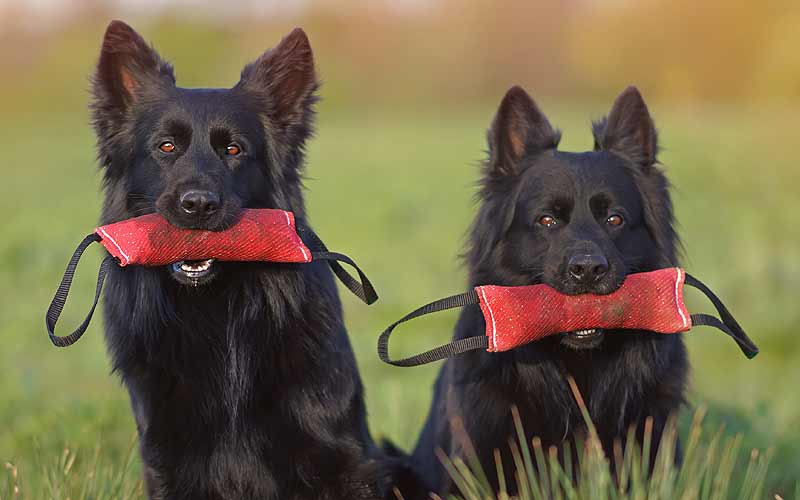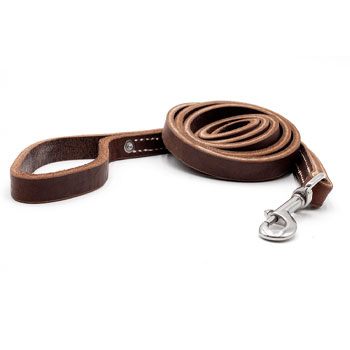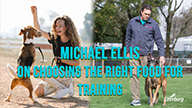German Bloodline Dogs vs. American Bloodline Dogs
Note: Leerburg formerly bred working bloodline German Shepherds until deciding to shift its focus towards producing dog training videos and courses alongside providing quality dog training equipment. This article was written when our breeding program was still active. While Leerburg no longer breeds working GSDs, we believe this article may still provide valuable information for those interested in starting their own breeding program.

We have built our reputation by breeding quality working dogs and backing them up with a fair guarantee. One of the ways we have maintained the working ability in our bloodline is through German working bloodlines.
The Germans have maintained working ability in their bloodline through the sport of Schutzhund. In Germany, you cannot register a litter of pups unless it has a Schutzhund working title. In Europe, a working title is either a Schutzhund title, a Herding title, or a Police Service Dog title. This means that if a dog does not have a good enough temperament to obtain a title, it cannot be bred. In addition, the German dogs are also required to get their hips x-rayed before breeding.
Here in America, if your neighbor has an AKC registered dog and your other neighbor has an AKC registered dog, they can be bred and their pups can be registered. It does not matter if they are both dysplastic or if they are both fear biters that cower in the corner when a stranger approaches.
The German Shepherd Dog Club of America is as much to blame as the AKC for the downfall of the working ability in the American breed. While the people that are members of the GSDCA are very nice people, their only interest is in producing a dog that can run in circles and look pretty. They pay lip service to the temperament of the breed and the majority have no concern about the working ability in their breeding program. In my opinion, the GSDCA is directly responsible for breeding the working ability out of the American Bloodline German Shepherds. They should rename their breed and call it the American Shepherd.
There is NOT ONE American bloodline that can consistently produce a police service dog. That is a very sad statement, but it is true. You can occasionally find an American bloodline breeder who will brag about having some of his dogs in a police department someplace, but the sad truth is that if the dog is working as a patrol dog, it does not belong there.
Most police departments don't have a clue about how to selection test a patrol dog. So when a local breeder offers to donate a dog (or sell a dog cheap), they jump on the opportunity. These dogs are taken through some form of training and then labeled a "police dog". The fact is that these dogs will not protect their handler if their lives depended on it. What's really bad is that many times, these uneducated officers don't even know that if the going gets tough, their dog is not going to be there when they really need him.
Unfortunately, the Germans seem to be moving in the same direction. The Germans have two separate sets of bloodlines in their country. They have their show lines and working lines. The two hardly ever cross. With 120,000 members of the German Shepherd Dog Club in Germany (the SV), there is a Schutzhund club in every small village.
These people are excellent trainers. They work their conformation dogs in prey drive from the time they are small puppies. This results in the show dog being titled in Schutzhund, but the titles are all done in prey drive. These dogs lack "fight drive." Basically, this means that the dogs look at Schutzhund as a game and the helper as a buddy to play tug of war with. The German show dogs lack "fight drive." They have had the fight drive bred out of them. They do not look at the helper as a fighting partner; they look at him as a buddy. Read my article on drives.
A Police Service Dog or a personal protection dog needs to have "fight drive" in his temperament. Fight drive is inherited; it is a genetic factor that cannot be trained into a dog. An animal either has it or it doesn't. Our dogs here at Leerburg Kennels are bred with fight drive in mind.
It is important that a newcomer to the breed does not confuse "fight drive" with "bad temperament" or "handler aggression." These three are totally separate issues in a dog's makeup. A dog can have excellent fight drive and still be very safe around children and in many cases, even around strangers. A dog does not have to exhibit its fight drive until it is attacked or its owners are attacked. When that happens, these dogs show the self-confidence to enter a fight with the knowledge that they can beat their attacker.
Dogs can have no fight drive and still have bad temperament. You only have to look at the American Shepherd to see this. Dogs can also be handler aggressive and have no fight drive. Many handler aggressive dogs show aggression through fear. This means that they have learned to show aggression when they are placed in a position where they are a stressed. They don't understand what they are expected to do. They react to stress by biting the handler. This is not fight drive.
Our kennel is not the only good breeding kennel for working bloodline dogs. If you cannot afford one of our dogs, at least make sure you are buying German working bloodlines and not German show lines, and for sure, not American lines.
I had a customer send me the following e-mail. Nick is a professional dog trainer in Canada. His e-mail brings interesting insights to this article:
My name is Nick Zevgolis and I'm a pet dog trainer in Montreal, Canada with a special interest in working dogs (police, search and rescue, narcotics detection, etc.). Over the years in my practice, the most disturbing part is having to evaluate what is commonly known as a "fear biter" and recommend that the owners put the dog down, knowing that the poor dog never had a chance. Most of the time, this could have been avoided had the people bought their dog from a breeder who emphasizes a proper temperament among other key characteristics. My point in writing this is to inform you that this will almost always come from a working dog breeder and rarely from a "show breeder."
In a working dog, most breeders are mainly looking at temperament, drives, nerves, health, trainability, and a willingness to please (depending on the specifics of the task intended). I will now explain these terms and explain how they differ between "show breeders" and "working breeders." If I offend anyone, I'm sorry, that isn't my intention.
Temperament is what we could loosely define as the dog's day-to-day attitude. In a working dog, most breeders want a Rock-Solid temperament. If a police dog is not stable around other officers on a search, of what value is he? By contrast, the only test of temperament that a show dog must go through is "stand for examination" by the judge. Even a spooked dog can be conditioned to pass this test with enough work (believe me, I know of many such cases.)
Drives are a dog's inherent desire to do or perform something. A working dog must have these in abundance or he cannot ever be a reliable dog. A show dog has no need for any drive. All he has to do is be "baited" by liver while he is in the show ring.
Health is a major concern of any good working breeder. This is self-explanatory, if a dog is in poor health he cannot be used to perform the task at hand for any length of time. Why would departments (who are all on a limited budget) invest money into an animal that cannot provide them with years of work? Believe me, these dogs cost a couple of bucks, so they need to last. A show line German Shepherd Dog is so angulated that his chances for having hip dysplasia are much greater. Just imagine the stress put on the dog's rear with that amount of angulation.
Nerves. A dog's nerves are important regardless of what function he will fill (pet, working dog, etc.). If his nerves are shaky, he is, at the very least, a difficult animal to live with, and at worst, a potential danger. A show dog's nerves are never truly tested so how can someone truly claim that their dogs have good nerves? By contrast, a working dog's nerves are tested on a daily basis in training, competing, working, and changing environments.
Trainability for a working dog is essential. Why would a trainer spend hundreds of hours on a dog when the training time can be cut in half with a dog who isn't a knucklehead? Ask yourself what a show breeder ever had to train a dog to do other than be baited by food. Now to the average dog owner, if your dog lacks true trainability, this isn't the end of the world. But why do it the hard way?
A pet dog owner does not need a dog with all the drive of a working dog, but a good working breeder can help you choose a pup in the litter that is a little more "toned down" and would make an easier house dog for your family. At least you can be assured of getting all the other positive traits.
Consider all this when looking for a dog and understand that once you've found the "perfect pup" it's easy to ruin him if you are careless in how you raise the dog. Get professional training and make a real commitment to your animal.
I just placed my female German Shepherd Dog into a new family because she lacked the drives I wanted in her in order to go on to "Doggy Ph.D." work. But she is extremely stable and trustworthy and is living with 3 young boys in the house (and all the friends that the 3 young boys bring over). I do not have children, but I exposed her to them at an early age, and she is now a treasured companion and "ice cream taste tester" extraordinaire.
Do your homework and be careful. Best of all, ask for trainer referrals and try to find a private trainer to help you in selecting a pup from a litter. Train and socialize the heck out of your dog and remember it's a lifelong process. It takes the right breeder, the right pup, the right owners, and the right trainer. If you get all this, it should be an extraordinarily rewarding time for you and your family.









Ask Cindy.